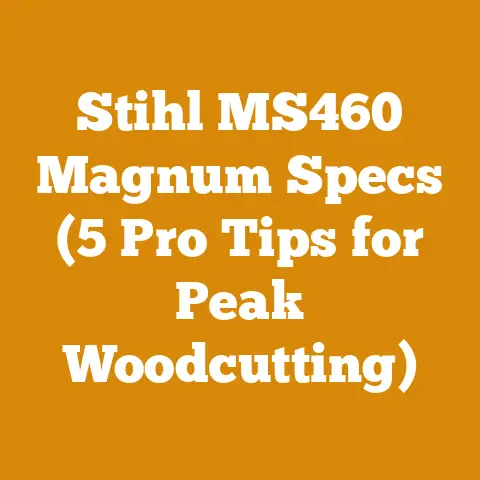How to Tell If a Maple Tree Is Dying (5 Expert Wood Signs)
Goal: To equip you with the knowledge to identify signs of decline in maple trees, enabling you to take proactive measures for their health or make informed decisions about their removal and utilization for wood processing or firewood.
This includes understanding the implications of a dying tree on wood quality and the costs associated with its harvesting and processing.
Introduction: My Maple Musings and the Value of Early Detection
I’ve always had a soft spot for maples.
Their vibrant fall colors are a sight to behold, and their wood is prized for its strength and beauty.
I remember one autumn, years ago, when I was just getting started with my firewood business.
I had my eye on a stand of maples on a neighbor’s property.
They were mostly sugar maples, perfect for long-burning, high-heat firewood.
But as I walked through the trees, I noticed something wasn’t quite right.
One of the larger trees had a significant amount of deadwood, and the bark was peeling in unusual patterns.
I knew enough to realize it wasn’t a healthy tree.
A dying maple can still be valuable, but the wood quality deteriorates rapidly, and the cost of harvesting and processing can increase significantly.
This article will guide you through five key signs that indicate a maple tree might be dying.
We’ll delve into the visual cues, discuss the underlying causes, and, importantly, explore the implications for wood processing, firewood preparation, and the associated costs.
We’ll also look at some practical ways to assess wood quality and make informed decisions about whether to try to salvage the wood or simply let nature take its course.
1. Canopy Dieback: A Crown of Trouble
What it is: Canopy dieback refers to the progressive death of branches, starting at the tips and moving inward towards the trunk.
It’s often one of the first and most visible signs that a maple tree is under stress.
How to Spot It:
- Sparse Foliage: Noticeably fewer leaves than normal, especially in the upper crown.
- Dead Branch Tips: Twigs and small branches that are bare or have only a few withered leaves.
- Branch Size Reduction: A gradual shrinking in the size of new branch growth.
- Overall Thinning: The tree’s crown appears less dense and more see-through than healthy trees nearby.
Why It Matters (Wood Processing Perspective):
Canopy dieback signals a decline in the tree’s overall health.
This decline impacts the wood’s density and structural integrity.
Wood from trees experiencing dieback is often weaker, more prone to cracking and warping, and has a higher moisture content.
This affects its suitability for various wood processing applications.
Cost Implications:
- Increased Drying Time: Higher moisture content means longer drying times, which can increase storage costs and delay project timelines.
- Lower Yield: More cracking and warping during drying can lead to a lower yield of usable lumber.
- Reduced Market Value: The lower quality wood will command a lower price in the market.
- Increased Labor: The increased defects in the wood may require more labor to process and prepare it for use.
Data Point: According to a study by the US Forest Service, trees experiencing significant canopy dieback can have a 20-30% reduction in wood density compared to healthy trees.
This reduction directly impacts the wood’s strength and durability.
My Experience: I once harvested a maple tree that showed only minor canopy dieback from the ground.
However, once I got up close, I realized the dieback was much more extensive than I initially thought.
The wood was riddled with small cracks, and the drying process was a nightmare.
I ended up losing a significant portion of the lumber to warping.
That experience taught me to always inspect the canopy closely before deciding to harvest a tree.
2. Bark Abnormalities: A Skin Deep Story
What it is: The bark is a tree’s protective layer.
Changes in its appearance, texture, or the presence of unusual growths can indicate underlying problems.
How to Spot It:
- Peeling Bark: Large patches of bark peeling away from the trunk, especially if it’s not a species known for exfoliating bark.
- Cracks and Cankers: Deep splits or sunken, dead areas on the bark, often caused by fungal or bacterial infections.
- Discoloration: Unusual patches of color, such as black, white, or orange, which may indicate fungal growth.
- Sap Oozing: Excessive sap flow from wounds or cracks, often a sign of stress or infection.
- Insect Activity: Holes or tunnels in the bark, indicating insect infestation.
Why It Matters (Wood Processing Perspective):
Bark abnormalities often signal fungal or insect infestations that can penetrate the wood, causing decay, discoloration, and weakening of the wood fibers.
Cost Implications:
- Increased Waste: Decayed wood is unusable and increases the amount of waste material.
- Higher Processing Costs: Infested wood may be more difficult to saw and process due to its weakened structure.
- Equipment Damage: Insects and fungal spores can damage saw blades and other wood processing equipment, leading to increased maintenance costs.
- Health Risks: Some fungal infestations can pose health risks to workers handling the wood.
Data Point: A study by the University of Minnesota found that maple trees with cankers caused by Nectria fungi can experience a 15-25% reduction in usable lumber yield due to decay.
My Experience: I once bought a load of maple logs from a local supplier.
They looked good from the outside, but when I started milling them, I discovered that several logs had extensive fungal decay hidden beneath the bark.
I ended up losing a significant amount of money on that purchase.
Now, I always carefully inspect the bark of every log before I buy it.
3. Fungal Growth: The Unseen Enemy
What it is: Fungal growth on a maple tree is a clear sign of decay and internal problems.
Fungi are decomposers, and their presence indicates that the tree’s defenses are compromised.
How to Spot It:
- Mushrooms or Conks: Fruiting bodies of fungi growing directly on the trunk or branches.
These can range in size, shape, and color. - Shelf Fungi: Bracket-like fungi that protrude from the trunk.
- Powdery or Cottony Growth: Patches of white, yellow, or orange powder or cottony material on the bark or wood.
- Root Rot: Fungal growth around the base of the tree, often accompanied by a spongy or decaying texture in the soil.
Why It Matters (Wood Processing Perspective):
Fungal growth directly attacks the wood’s structure, causing decay, discoloration, and a significant reduction in strength.
Wood affected by fungal decay is generally unsuitable for most wood processing applications.
Cost Implications:
- Unusable Wood: Severely decayed wood has little to no value and must be discarded.
- Increased Disposal Costs: Disposing of large quantities of decayed wood can be expensive.
- Contamination Risk: Fungal spores can spread to other wood piles, potentially contaminating healthy wood.
- Safety Hazards: Decayed wood is more likely to break or collapse during processing, posing a safety hazard to workers.
Data Point: Research from the Forest Products Laboratory shows that certain types of wood-decaying fungi can reduce the strength of maple wood by as much as 50% within a few years.
My Experience: I once tried to salvage a maple tree that had a large conk growing on its trunk.
I thought I could cut around the decay and still get some usable lumber.
However, once I started milling the tree, I discovered that the decay was much more extensive than I had anticipated.
The wood was soft, spongy, and discolored.
I ended up throwing away almost the entire tree.
It was a costly lesson in the destructive power of fungal decay.
4. Weak Branch Unions: A Structural Flaw
What it is: Weak branch unions occur when branches are poorly attached to the trunk, making them prone to breakage, especially during storms or heavy snow.
How to Spot It:
- Narrow Angles: Branches that grow at a very narrow angle to the trunk, forming a “V” shape rather than a wider “U” shape.
- Included Bark: Bark that is trapped between the branch and the trunk, creating a weak point.
- Cracks or Splits: Visible cracks or splits at the point where the branch joins the trunk.
- Hanging Limbs: Branches that are partially broken or hanging loosely from the tree.
Why It Matters (Wood Processing Perspective):
Weak branch unions indicate a structural weakness in the tree.
This weakness can extend into the trunk, affecting the overall stability and quality of the wood.
Trees with weak branch unions are also more likely to suffer windthrow, which can damage other trees and property.
Cost Implications:
- Increased Harvesting Costs: Trees with weak branch unions are more difficult and dangerous to harvest, requiring specialized equipment and techniques.
- Lower Lumber Yield: The presence of included bark and cracks can reduce the amount of usable lumber.
- Increased Risk of Injury: Weak branches can break unexpectedly during harvesting, posing a safety risk to workers.
- Higher Insurance Costs: Companies that harvest trees with weak branch unions may face higher insurance premiums due to the increased risk of accidents.
Data Point: A study by the International Society of Arboriculture found that trees with included bark at branch unions are up to 10 times more likely to fail during storms than trees with strong, well-formed branch unions.
My Experience: I once witnessed a large maple tree with weak branch unions collapse during a windstorm.
The tree fell across a power line, causing a widespread power outage.
The cost of repairing the power line and removing the tree was substantial.
That experience taught me the importance of identifying and addressing weak branch unions before they cause damage.
5. Stunted Growth: A Sign of Underlying Stress
What it is: Stunted growth refers to a noticeable slowing or cessation of growth in a maple tree.
This can manifest as smaller leaves, shorter branch growth, and a reduced overall size compared to healthy trees of the same age and species.
How to Spot It:
- Small Leaves: Leaves that are significantly smaller than normal for the species.
- Short Internodes: Shorter distances between leaf nodes on branches, indicating reduced branch growth.
- Lack of New Growth: Little or no new growth in the current growing season.
- Overall Small Size: The tree is significantly smaller than other trees of the same age and species in the area.
Why It Matters (Wood Processing Perspective):
Stunted growth indicates that the tree is not thriving and may be experiencing nutrient deficiencies, root problems, or other stressors.
This can affect the wood’s density, grain pattern, and overall quality.
Cost Implications:
- Lower Timber Volume: A stunted tree will yield less timber than a healthy tree of the same age.
- Poorer Wood Quality: The wood may be less dense, more brittle, and more prone to defects.
- Longer Rotation Times: If the tree is being grown for timber, stunted growth will delay the harvest and reduce the overall profitability of the operation.
- Increased Management Costs: Stunted trees may require more intensive management, such as fertilization and pest control, to improve their growth and health.
Data Point: Research from the University of Wisconsin-Madison shows that stunted maple trees can have a 10-15% reduction in wood density compared to healthy trees.
My Experience: I once purchased a small woodlot with several maple trees that were showing signs of stunted growth.
I initially thought I could improve their growth with fertilization and pruning.
However, after several years of effort, the trees still failed to thrive.
I eventually realized that the soil was too acidic and poorly drained to support healthy maple growth.
I ended up having to replant the area with a more suitable species.
The Firewood Factor: Dying Maple as Fuel
While dying maple might not be ideal for high-end woodworking, it can still be a valuable source of firewood.
However, there are considerations:
- Increased Moisture Content: Dying trees often have higher moisture content, requiring longer drying times.
This can impact the efficiency of burning and increase the risk of creosote buildup in chimneys. - Potential for Decay: Even if the wood appears sound, internal decay can be present, reducing its BTU (British Thermal Unit) output.
- Harvesting Challenges: Dying trees may be more brittle and prone to breakage, requiring extra caution during felling and processing.
Cost Considerations for Firewood:
- Increased Labor: Cutting and splitting wood from a dying tree can be more challenging, requiring more time and effort.
- Longer Drying Time: The increased moisture content necessitates a longer drying period, potentially delaying sales or use.
- Lower Selling Price: Firewood from dying trees may command a lower price due to potential decay or lower BTU output.
My Firewood Story: I’ve salvaged many dying maples for firewood.
I always check for rot and insect infestation before processing.
My method involves splitting the wood smaller than usual and stacking it loosely to promote faster drying.
I also have a moisture meter to ensure the wood is below 20% moisture content before selling it.
Budgeting for Maple Tree Removal and Utilization: A Practical Guide
Let’s break down the costs associated with removing a dying maple tree and utilizing its wood:
Scenario: You have a large maple tree (30 inches diameter at breast height – DBH) that is showing signs of decline.
You want to remove the tree and either process the wood yourself or sell it.
Cost Components:
- Tree Removal:
- Professional Arborist: Hiring a professional arborist to remove the tree can cost anywhere from $500 to $2,000 or more, depending on the size of the tree, its location, and the complexity of the removal.
Factors like proximity to power lines or buildings can significantly increase the cost.
Source: HomeAdvisor - DIY Removal: If you choose to remove the tree yourself, you’ll need to factor in the cost of equipment rental (chainsaw, wood chipper, etc.) and safety gear.
Chainsaw rental can range from $50 to $100 per day, while a wood chipper can cost $100 to $300 per day.
Source: Sunbelt Rentals
- Professional Arborist: Hiring a professional arborist to remove the tree can cost anywhere from $500 to $2,000 or more, depending on the size of the tree, its location, and the complexity of the removal.
- Wood Processing:
- Firewood:
- Splitting: If you’re processing the wood for firewood, you’ll need a wood splitter.
A manual splitter can cost around $100 to $300, while a gas-powered splitter can range from $1,000 to $3,000.
Source: Northern Tool + Equipment - Labor: Factor in your time for cutting, splitting, and stacking the wood.
A cord of firewood can take anywhere from 8 to 16 hours to process, depending on your experience and equipment.
- Splitting: If you’re processing the wood for firewood, you’ll need a wood splitter.
- Lumber:
- Milling: If you’re milling the wood into lumber, you’ll need access to a sawmill.
Hiring a portable sawmill operator can cost $500 to $1,000 per day.
Source: Forestry Forum - Drying: Air-drying lumber can take several months to a year, depending on the species and thickness of the wood.
Kiln drying can shorten the drying time but will add to the cost.
Kiln drying rates typically range from $0.50 to $1.50 per board foot.
Source: Wood-Mizer
- Milling: If you’re milling the wood into lumber, you’ll need access to a sawmill.
- Firewood:
- Disposal:
- Stump Removal: Grinding the stump can cost $100 to $400, depending on the size of the stump and the accessibility of the location.
Source: Thumbtack - Waste Disposal: Hauling away branches and other debris can cost $50 to $200, depending on the volume of material and the distance to the disposal site.
- Stump Removal: Grinding the stump can cost $100 to $400, depending on the size of the stump and the accessibility of the location.
Example Budget:
Let’s assume you hire a professional arborist to remove the tree ($1,000), split the wood for firewood using a rented gas-powered splitter ($150/day), and dispose of the stump ($200).
- Tree Removal: \$1,000
- Splitter Rental (2 days): \$300
- Stump Removal: \$200
- Total: \$1,500
Revenue Potential:
A 30-inch DBH maple tree can yield approximately 2-3 cords of firewood.
The average price per cord of firewood varies depending on location and species but typically ranges from $200 to $400.
- Potential Revenue (2.5 cords x $300/cord): \$750
Net Cost:
- Total Cost: \$1,500
- Potential Revenue: \$750
- Net Cost: \$750
In this scenario, you would incur a net cost of $750 to remove the tree and process the wood for firewood.
However, the actual cost and revenue will vary depending on your specific circumstances.
Cost Optimization Tips:
- Get Multiple Quotes: Obtain quotes from several arborists and sawmill operators to ensure you’re getting the best price.
- DIY When Possible: If you’re comfortable and have the necessary skills and equipment, consider removing the tree and processing the wood yourself.
- Sell the Wood: If you don’t need the firewood or lumber yourself, consider selling it to recoup some of your costs.
- Negotiate Prices: Don’t be afraid to negotiate prices with contractors and suppliers.
- Consider Seasonality: The cost of tree removal and firewood can vary depending on the season.
Prices may be lower during the off-season.
My Budgeting Trick: I always add a 10-15% contingency to my budget to account for unexpected costs, such as equipment breakdowns or unforeseen problems with the tree.
The Legal Landscape: Permits and Regulations
Before removing a maple tree, it’s essential to check with your local authorities to determine if any permits or regulations apply.
Many municipalities have tree protection ordinances that restrict the removal of trees, especially those located on public property or in protected areas.
Failure to comply with these regulations can result in fines and other penalties.
Example: In some areas, you may need a permit to remove a tree that is above a certain size or located within a certain distance of a waterway.
You may also need to obtain permission from your homeowner’s association if the tree is located on common property.
Data Point: A survey by the National Arbor Day Foundation found that over 70% of US cities have tree protection ordinances in place.
My Legal Lesson: I once removed a tree from my property without checking with the local authorities first.
I received a warning letter and was required to replant a tree to compensate for the one I removed.
Now, I always check the regulations before removing any tree.
Actionable Takeaways and Next Steps
Identifying the signs of a dying maple tree is the first step towards making informed decisions about its future.
Here’s what you should do next:
- Thorough Inspection: Conduct a thorough inspection of your maple trees, looking for the signs discussed in this article.
- Consult an Arborist: If you suspect that a tree is dying, consult with a certified arborist for a professional assessment.
- Develop a Plan: Based on the arborist’s recommendations, develop a plan for either treating the tree or removing it.
- Budget Accordingly: Create a detailed budget for the tree removal and wood processing, taking into account all the cost components discussed in this article.
- Check Local Regulations: Ensure that you comply with all local regulations and obtain any necessary permits before removing the tree.
- Utilize the Wood Wisely: If possible, utilize the wood for firewood, lumber, or other purposes to recoup some of your costs.
Conclusion: From Tree to Treasure – A Sustainable Approach
Dealing with a dying maple tree can be a challenging but also an opportunity.
By understanding the signs of decline, carefully planning the removal and utilization process, and budgeting effectively, you can turn a potential loss into a valuable resource.
Whether you’re using the wood for firewood, lumber, or other purposes, remember to adopt a sustainable approach that minimizes waste and maximizes the value of the tree.
And, like me, you’ll learn to appreciate the beauty and utility of maple wood, even as you navigate the complexities of tree health and wood processing.
Keep your chainsaw sharp, your eyes peeled for those telltale signs, and remember that even in death, a maple tree can offer a wealth of resources and lessons.






